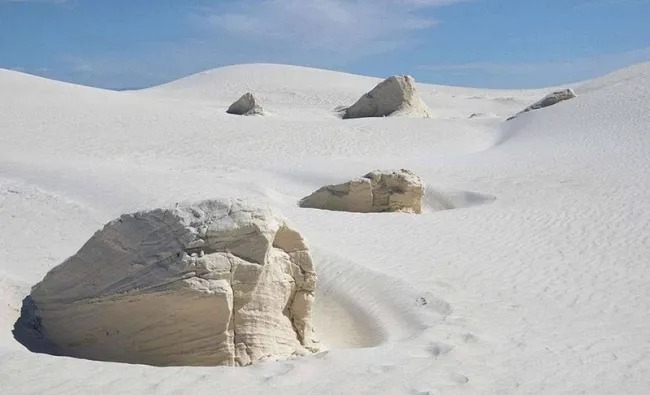
White Sands National Park, located in southern New Mexico, is a stunning natural wonder featuring the largest gypsum dune field in the world. This expansive landscape of glistening white sand covers approximately 275 square miles, offering visitors an ethereal experience. The park's unique environment is home to a variety of wildlife and plant species that have adapted to the harsh desert conditions. White Sands is a place of beauty and serenity, attracting nature lovers, photographers, hikers, and stargazers from around the world.
History of the Park
White Sands became a national monument on January 18, 1933, through President Herbert Hoover's proclamation. Over the years, efforts to protect and preserve this natural wonder increased, and on December 20, 2019, it was designated as White Sands National Park, becoming the 62nd national park in the U.S. The area has a long history of human habitation, dating back over 10,000 years. Evidence of ancient hunting and gathering activities has been found in the region, and the area has significance to various Native American tribes.
Main Features
The main feature of White Sands National Park is, of course, the vast dune field made of gypsum crystals. Unlike typical sand made of quartz, gypsum sand is softer and cooler to the touch, even in the heat of the day. The park also features the Dune Life Nature Trail, an interpretive trail that showcases the flora and fauna that thrive in this unique environment. The Interdune Boardwalk offers visitors an accessible way to explore the dunes, with informational panels about the ecosystem and geology of the area.
Another highlight of the park is its stargazing opportunities. Due to its remote location, the park offers some of the darkest skies in the country, making it a prime location for stargazing and night photography.
Types of Trails
White Sands National Park offers a variety of trails suited for different levels of hiking experience:
- Dune Life Nature Trail - A 1-mile loop that provides insight into the wildlife and plant life of the dunes.
- Playa Trail - A short, flat 0.5-mile trail that leads to a dry lakebed, offering opportunities to see animal tracks.
- Interdune Boardwalk - A fully accessible 0.4-mile boardwalk trail, perfect for those looking for a less strenuous way to enjoy the dunes.
- Alkali Flat Trail - The park’s most challenging hike, this 5-mile round-trip trail takes visitors deep into the dunes and offers spectacular views of the surrounding mountains.
Crowd Expectations and Annual Visitors
White Sands National Park sees around 600,000 visitors annually. The park can be quite busy during weekends and holidays, especially in the cooler months from October to April. Despite the open space, the visitor center and main parking areas can become crowded, particularly around midday. For a quieter experience, visiting early in the morning or later in the afternoon is recommended.
Accessibility for Seniors and Wheelchairs
White Sands National Park offers several accessible options for seniors and those with mobility issues. The Interdune Boardwalk is a wheelchair-accessible trail that provides a fantastic experience of the dunes without the need to hike on the soft sand. The visitor center is also fully accessible, with paved pathways, accessible restrooms, and exhibits.
For seniors, the park's relatively flat terrain and short trails provide a pleasant and manageable experience. Visitors can also drive the Dunes Drive, a scenic road that loops through the heart of the park, allowing for easy access to various stops without much walking.
Park Amenities
The park has a visitor center that offers exhibits, a gift shop, and information about the park. Restrooms are available at the visitor center and along the main road, Dunes Drive. Additionally, picnic areas with covered tables are scattered throughout the park, providing shade and a place to rest or enjoy a meal amidst the dunes.
Camping Facilities
White Sands National Park does not have developed campgrounds, but it offers backcountry camping for those seeking a more adventurous experience. There are ten designated backcountry camping sites, which require a permit and involve a short hike into the dunes. Campers must be prepared for extreme temperature changes and carry sufficient water, as there are no water sources in the backcountry areas.
Access to Lodging
The nearest lodging options are in Alamogordo, about 15 miles from the park. Alamogordo offers a range of accommodations, from budget motels to more comfortable hotels. Visitors can also find camping and RV parks in the surrounding area, but it is important to note that there are no lodging facilities within the park itself.
Pet-Friendliness
White Sands National Park is pet-friendly, and visitors are welcome to bring their pets to explore the park. Pets must be kept on a leash no longer than six feet at all times, and owners are required to clean up after their pets. The park's hot sand and extreme temperatures can be tough on pets, so it’s essential to bring plenty of water and provide shade when needed.
Best Months to Visit
The best time to visit White Sands National Park is from October to April when temperatures are cooler and more comfortable for outdoor activities. Summer temperatures can soar above 100°F (38°C), making hiking and exploring more challenging, especially during the day. The park is open year-round, but fall, winter, and early spring offer the most pleasant weather conditions.
Conclusion
White Sands National Park is a breathtaking destination that offers a unique landscape unlike any other in the United States. From the shimmering white gypsum dunes to the vibrant desert wildlife, this park provides a peaceful and awe-inspiring retreat. Whether you’re hiking the dunes, stargazing at night, or simply enjoying a scenic drive, White Sands offers a memorable experience for all who visit. Its accessibility and pet-friendly policies make it a welcoming destination for a wide range of visitors, and its natural beauty ensures it will remain a cherished national treasure for generations to come.



